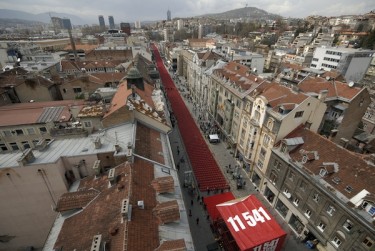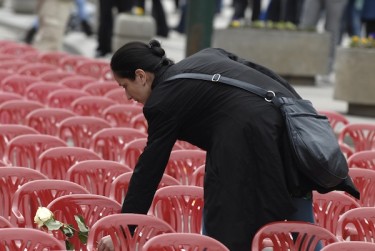Wednesday, April 11, 2012
A red plastic chair for each person killed in Sarajevo in the war that began 20 years ago. A whole street lined up with red chairs, all empty but for some flowers on some of them. Those who could have sat in these chairs - 11,541 people - are long gone.
On April 6, thousands of people came to this stunning makeshift memorial stretching along Sarajevo's main street, in order to honor the memory of the victims of the Siege of Sarajevo, which lasted from April 5, 1992, to February 29, 1996 (some of the photos of the memorial are here, here, and here).

Red chairs are displayed along Sarajevo's main street as the city marks the 20th anniversary of the start of the Bosnian War. 11541 red chairs represent the 11,541 Sarajevans who were killed in the 1992-1995 siege of Sarajevo. Photo by SULEJMAN OMERBASIC, copyright © Demotix (04/06/12)
Online, numerous texts have appeared around the time of the sad anniversary; memories, photos and thoughts on the meaning of what went on in Bosnia in the 1990s abound (e.g., here, here, here, here, and here).
On April 5, Damir Šagolj, a Bosnian photojournalist and a survivor of the siege - who, in October 2011, posted a powerful photo report on his visit to the detention facility for war criminals in the Hague, aka "the Hague Hilton - wrote this about his wartime memories and work:
[...] I don’t have any of my pictures from the 92-95 anymore. I shot many – mostly of dead people, of destruction. Very few had any life in them. Then, just as killings stopped and a different war continued in November 1995 I abandoned my photos; I didn’t want to have them anymore.
Not a smart move, but it was what I wanted at the moment – to forget, to put behind. To move forward.
All I have now are the cracks in my memory to peek through and imagine lives before we became just numbers. Only the weed grows around ruins, just like nails and hair on the dead bodies – the reminder.
I had all my photos in one room, at my former army unit in Vrazova street. I would walk past that building every day and all I had to do is to use the key I kept for many years after and pick up my films. I didn’t. Then a rich man bought the building and my archive went where I wanted it to go – into trash.
No matter how hard I try to explain what I did, it doesn’t work. Then, just a moment after, it all makes perfect sense again.
Soon after, it all became very abstract – the faces faded into shapes, names into numbers, lives into bones… I don’t trust my memory any more, it is selective and dazed.
That’s why it was important in Sarajevo to have people from outside who were stronger and more sober. They meet these days in Sarajevo for the big anniversary re-union. Probably only very few really understand how important was what they were doing 92-95.
Without them, the history would be written by same those who killed the man.
Thank you.
A Facebook page - Sarajevo 2012: A Meeting of War Reporters & Sarajevo Friends - was set up for the journalists' reunion; it contains the schedule of events, photos and notes from some of those who were able to attend. Edward Serotta, journalist, photographer and the director of Centropa.org, wrote this:
[...] Last weekend was one long emotional charge--it was like holding on to an electrical current and as soon as I let go of it, I felt everything drain away. Being together with so many people I respect, and who gave their all to bring this story to the world twenty years ago, was, at least for me, ennobling. [...]
We all shared the same cause back then (those who came to Sarajevo for the reunion and those who didn't): to bear witness--photograph, record, document the events that proved the so-called civilized world was eating itself alive. We risked life and limb to do it, and lived very much on the edge--and we lived very intensely. [...]
All that intensity we put into our work and all that commitment to document the horrors and the bravery, the big stories and the small, are way behind us now. [...] But for one blustery April weekend in 2012, a few of us gathered together and remembered what we shared, what we covered, how we lived, and how we tried to help--in that limited way that each of us could.
Photojournalist Gary Knight posted this note:
Sitting in my studio in Boston reflecting on the last four days in Sarajevo - one of the most emotional experiences I think I have ever had. A bitter sweet embrace with a city and cherished friends with whom I shared so many defining experiences during the utter despair of the siege. As wonderful as it was to see you all I left wondering how peace could have gone so badly wrong. Bosnia deserved a better peace than the one Dayton gave it. I have travelled far and wide since the war in Bosnia ended but rarely to a place as utterly depressing. There is much we can still do there...........
Zdenka Pregelj (@CountessBezuhov), a Sarajevo native who has been photographing the city since 2005, posted Nic Robertson's CNN report from the journalists' reunion and wrote:
This is very emotional for me. At that time I worked for Television in Sarajevo and was meeting Nic and Chris day in day out. Thank you Nic for coming back after 20 years.

A Bosnian woman, Berina Hodzic, lays a flower on one of the red chairs that were installed along Sarajevo's main street to mark the 20th anniversary of the start of the Bosnian War. Photo by SULEJMAN OMERBASIC, copyright © Demotix (04/06/12)
For the past few weeks, YakimaGulagLiteraryGazett and Sarajevo Seyahatname have been posting links to media and blog coverage of the 20th anniversary of the Bosnian War. The latter posted a link to this short item from Pictures of War, a Tumblr blog, about "some unsung heroes of the Sarajevo Siege" - James Mason's 1992 photo of Sarajevo's garbage collectors, accompanied by this note:
“Being a trashman in Sarajevo was probably as dangerous as being a frontline soldier. A lot of them died in the course of their work, either shot dead by snipers or killed by artillery. Without trash pickup the city would have descended into a middle-ages like morass of filth and disease.”
Another photo by James Mason has been used to illustrate an article about the anniversary [sr] that appeared in the Serbian online newspaper e-novine.com. The links to this and several other related articles (including the one [sr] on the memorial rally organized by Žene u crnom ("Women in Black") in Belgrade) were provided by Belgrade-based Pedja Popovic, in a comment to the BalkanInsight report stating that "[n]o one from the Serbian government will attend the April 6 commemoration of the start of the Bosnian Serb siege [of Sarajevo]. Popovic wrote:
Not all of media in Serbia ignored sad anniversary. [...]
James Mason's photo, taken in winter 1993, is of a girl holding a few loaves of bread, with a breadline in the background - and here is the photographer's description:
Distribution of bread
Sarajevo
This girl had just received her family's bread ration. I had hooked up with a kid about 11 and he was guiding me around the city, showing me where it was safe to walk. The girl was a friend of his from school and was glad to see him. It's amazing how fast the kids in Sarajevo adapted to the war.
Reader lalos posted this comment [sr] about the photo in the comments section at e-novine.com:
Rasplaka me ona slika sa devojčicom koja je puna sreće jer drži nekoliko vekni hleba u naručju.
Prokleti ratovi i oni koji su bombardovali Sarajevo.
This photo of the girl who is very happy because she's got a few loaves of bread in her hands has made me cry.
Damn wars and those who bombed Sarajevo.
Damn wars and those who bombed Sarajevo.
No comments:
Post a Comment